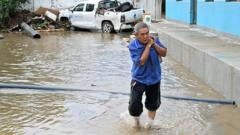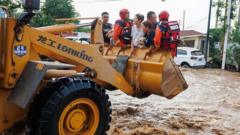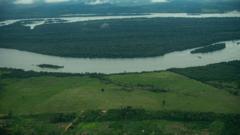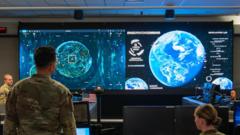In an unprecedented collaboration between Indian Space Research Organisation (ISRO) and NASA, the upcoming launch of the NASA-ISRO Synthetic Aperture Radar (NISAR) satellite aims to enhance global understanding of environmental changes, offering critical data for disaster management.
**India and US Prepare to Launch Groundbreaking Earth Observation Satellite**
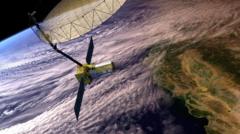
**India and US Prepare to Launch Groundbreaking Earth Observation Satellite**
A pioneering satellite set to launch soon will monitor Earth's changes, significantly aiding disaster readiness and climate studies.
The joint mission between India and the U.S. marks a notable milestone in space technology, aimed at revolutionizing Earth observation. Slated to launch from the Satish Dhawan Space Centre, this 2,392kg satellite is touted as NASA's "most sophisticated radar" built to date. Scheduled for 17:40 IST (12:10 GMT) on Wednesday, NISAR promises to provide comprehensive monitoring of minute changes across land, sea, and ice.
Utilizing dual radar frequencies—NASA's L-band and ISRO's S-band—NISAR will conduct detailed reconnaissance of the Earth's surface every 12 days. It is designed to detect shifts as minor as a few centimeters, capturing data crucial for understanding natural and human-induced changes. Former NASA scientist Mila Mitra highlighted the satellite's capability to identify precursors to natural hazards, land deformation, and climate change impacts.
NASA’s director of Earth Sciences, Karen St Germain, emphasized the satellite's potential in unveiling insights into earthquakes, landslides, glacial melt, and even forest fires, underlining its significance in enhancing disaster preparedness and tracking various environmental phenomena.
With a budget of $1.5 billion, the project spans over a decade and symbolizes a deepening partnership between India and the U.S. in space exploration. ISRO chairman V. Narayanan expressed pride in the mission, labeling it a “life-saving satellite” that illustrates India's growing prowess in the space arena. Indian Science Minister Jitendra Singh heralded the launch as a defining moment for international collaborations in space.
The launch comes on the heels of recent advancements in India's space endeavors, including a historic lunar landing and plans for its first human spaceflight by 2027, alongside ambitious goals of establishing a space station by 2035 and a manned Moon mission by 2040.
As NISAR prepares for its crucial deployment, the world anticipates the wealth of information that will contribute to our preparedness against environmental challenges, securing a brighter future for global communities.
Utilizing dual radar frequencies—NASA's L-band and ISRO's S-band—NISAR will conduct detailed reconnaissance of the Earth's surface every 12 days. It is designed to detect shifts as minor as a few centimeters, capturing data crucial for understanding natural and human-induced changes. Former NASA scientist Mila Mitra highlighted the satellite's capability to identify precursors to natural hazards, land deformation, and climate change impacts.
NASA’s director of Earth Sciences, Karen St Germain, emphasized the satellite's potential in unveiling insights into earthquakes, landslides, glacial melt, and even forest fires, underlining its significance in enhancing disaster preparedness and tracking various environmental phenomena.
With a budget of $1.5 billion, the project spans over a decade and symbolizes a deepening partnership between India and the U.S. in space exploration. ISRO chairman V. Narayanan expressed pride in the mission, labeling it a “life-saving satellite” that illustrates India's growing prowess in the space arena. Indian Science Minister Jitendra Singh heralded the launch as a defining moment for international collaborations in space.
The launch comes on the heels of recent advancements in India's space endeavors, including a historic lunar landing and plans for its first human spaceflight by 2027, alongside ambitious goals of establishing a space station by 2035 and a manned Moon mission by 2040.
As NISAR prepares for its crucial deployment, the world anticipates the wealth of information that will contribute to our preparedness against environmental challenges, securing a brighter future for global communities.

